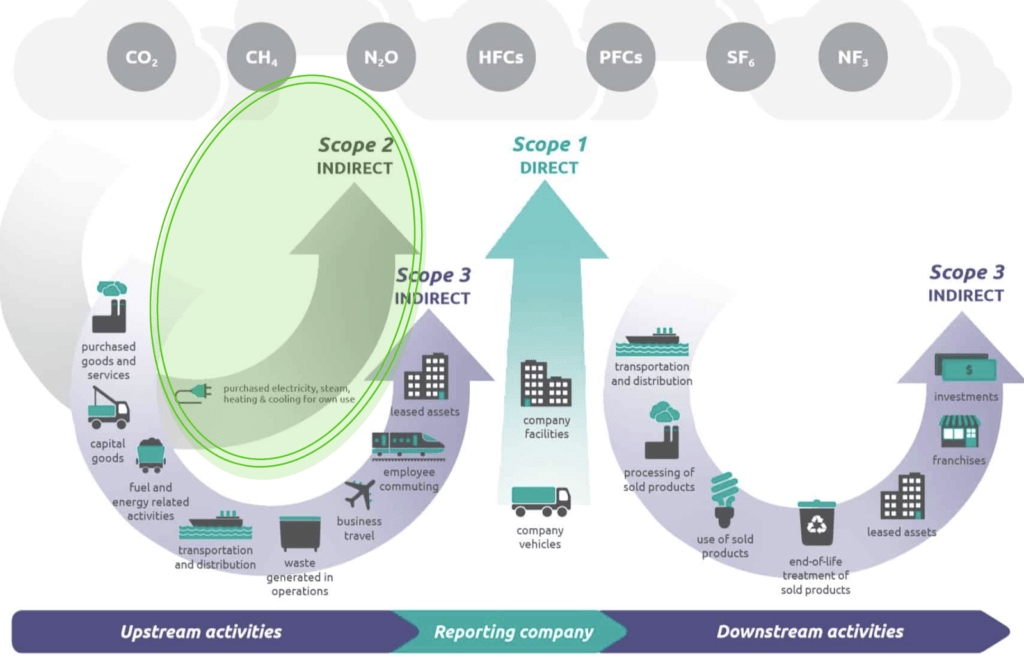Almost 40% of our global greenhouse gas emissions can be traced back to energy generation. And half of that energy is used by industrial or commercial entities.
It’s time for companies to take responsibility, become transparent on their carbon footprint, and start reducing them.
Read everything about scope 2 emissions and how to measure them below.
Quick Recap: What Are Scope 1, 2, and 3 Emissions?
If you want to reduce your carbon footprint, you first need to have a clear picture of your different kinds of emissions in order to connect them to data you can actually measure and monitor.
So how do I create this clear overview?
Well- the GHG (Greenhouse Gas) Protocol is here to help. The GHG Protocol was developed in the late ’90s and is the global standard framework for measuring and managing greenhouse gasses from both public or private organizations. And the GHG protocol established three scopes to measure emissions: scope 1, 2, and 3 emissions.
Scope 1: Emissions from scope 1 are direct emissions. This means that they directly come from your organization’s owned- or controlled source, such as; company vehicle emissions.
You can read everything about scope 1 emissions in our previous deep-dive article below.
Scope 2: Emissions in scope 2 cover the indirect emissions from purchased energy sources, such as your organization’s consumed electricity or cooling.
Scope 3: Emissions from scope 3 include all the other indirect emissions within your entire value chain, this includes the upstream supply chain (suppliers), as well as downstream GHG emissions e.g. occurring with customers.

Zooming in on scope 2 emissions.
So, let’s take a deep dive into scope 2 emissions.
Scope 2 emissions are your company’s indirect, owned, emissions. This means these emissions come from the generation of purchased energy by your utility provider.
Quickly summing it up: scope 2 emissions are all your GHG emissions that are released into the atmosphere and come from your consumption of purchased electricity, steam, heat, and cooling.
For most companies with manufacturing operations, scope 2 emissions will make up a very large part of their overall carbon footprint. The most logical reasoning for this is that most corporations get the majority of their energy from public utilities instead of generating their own. These utilities often still generate their energy from ‘brown power sources’- sources that burn fossil fuel. This results in the release of carbon emissions that a company- so to say- ‘indirectly purchases’.

Image 1. Scope 1, 2, and 3 emissions. Original Infographic by Anthesis Group.
How can you calculate and report your carbon emissions?
So how do you calculate and report these emissions?
The Scope 2 guidance from the GHG Protocol, requires companies to use two reporting methods in order to disclose their scope 2 emissions:
- The market-based reporting method
- The location-based reporting method
When companies calculate the emissions from their local power grid, this is the so-called location-based method. This method reveals what a company is physically putting into the air.
When companies specifically look into the contracts they have with their electric utilities, this is the market-based method. This market-based method really gives insights into the emissions that companies are responsible for through their electricity purchasing decisions. Companies can include a number of contractual instruments in this method that reduce their scope 2 emissions. Think of the REC’s (Renewable Energy Certificates) or GO’s (Guarantees of Origin).
The GHG Protocol has provided 8 scope 2 quality criteria that all contractual instruments must meet in order to be a reliable data source for the market-based method. You can find them here.
Finally, the scope 2 Guidance also provides you with clear and useful guidance on how your corporate procurement decisions can count towards emissions targets, in which they inform on both short- and long-term decisions.
You can find the entire Scope 2 guidance by the GHG Protocol here.

Which method should I report on?
Both methods we just mentioned provide crucial information on a company’s carbon footprint and tangible insights for potential carbon reduction strategies.
However, although the Scope 2 guidance requires you to report on these two separate scope 2 reporting methods, you don’t necessarily have to report on two separate carbon footprint figures.
Indeed, as long as you are specific on which method you used, you can choose which scope 2 reporting method you want to include in your total carbon footprint. Of course, here it’s recommended to choose the method that is most consistent with your business goals and targets.
If scope 2 emissions are really ‘material’ to the company in question then the market-based approach is more appropriate since it is more accurate. However, for most organizations where scope 2 emissions are not dominant, the location-based approach will provide a solid foundation. Good to know: the location-based approach is less work, however, it also provides less depth in the scope 2 analysis.

